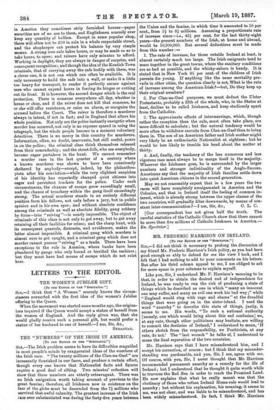THE "NUMBERS" OF THE IRISH IN AMERICA.
[To TR. EDITOR OF TIM “131.8CTATOR..]
Sia,—The Irish problem seems to have its difficulties magnified in most people's minds by exaggerated ideas of the numbers of the Irish race. "The twenty millions of the Clan.na-Gael" are incessantly flourished in our faces, and produce a certain effect, though every one knows that Nationalist facts and figures require a good deal of sifting. Two minutes' reflection will show that these numbers are utterly extravagant There was no Irish emigration worth taking account of previous to the great famine ; therefore, all Irishmen now in existence on the face of the globe must be descended from the 7f millions who survived that awful calamity. The greatest increase of the Irish moo ever substantiated was daring the forty-five years between the Union and the famine, in which time it amounted to 50 per cent., from 51 to 8f millions. Assuming a proportionate rate of increase since—i.e., 421 per cent, for the last thirty-eight years—the present numbers of the Irish, at home and abroad, would be 10,300,000. Bat several deductions must be made from this number :— 1. The rate of increase, for those outside Ireland at least, is almost certainly much too large. The Irish emigrants tend to mass together in the great towns, where the sanitary conditions are as bad as possible, and the whisky-saloon is handy. It is stated that in New York 85 per cent of the children of Irish parents die young. If anything like the same mortality pre- vails in other cities, the question clearly is not, What is the rate of increase among the American-Irish ?—but, Do they keep up their original numbers ?
2. For Clan-na-Gael purposes, we must deduct the Ulster Protestants, probably a fifth of the whole, who, in the States at least, decline to be called Irishmen, and keep studiously apart from the Catholics.
3. The approximate effects of intermarriage, which, though rather the exception than the rule, must often take place, are more difficult to calculate ; but the natural tendency would be more often to withdraw recruits from Clan-na-Gael than to bring them in. The eon of an American father and Irish mother might very likely be an enthusiastic Nationalist at eighteen; but he would be less likely to trouble his head about the matter at thirty.
4. And, finally, the tendency of the less numerous and less vigorous race must always be to merge itself in the majority. Wherever the Irishman goes, he is surrounded by the larger numbers and stronger individuality of the Anglo-Saxons. Americans say that the majority of Irish families settle down into quiet American citizens in the second generation.
May we not reasonably expect that in a few years the two races will have completely amalgamated in America and the Colonies, and that in Ireland itself the feeling of common in- terest, which is already strong between the upper classes of the two countries, will gradually filter downwards, by means of con- stant inter-communication P—I am, Sir, &c., a L. C.
[Our correspondent has not given half the truth. The careful statistics of the Catholic Church show that there cannot be more than five millions of Catholic Irishmen in America.— En. Spectator.]


































 Previous page
Previous page